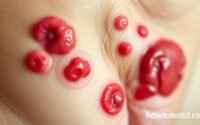STD & STI Symptoms: Dr. Liza Ramoso-Ong’s Tips
Did you know 1 in 5 people in the U.S. have an STI? This shows how important it is to know about STD symptoms. Dr. Liza Ramoso-Ong shares tips on spotting these symptoms early. This is key to handling them well.
By learning about STI symptoms, you can protect your health. You’ll know when to see a doctor. This helps keep you safe and healthy.

Key Takeaways
- Understanding STD and STI symptoms is essential for early intervention.
- Regular testing is key for good sexual health.
- Knowing the mental effects of STDs is important.
- Dr. Liza Ramoso-Ong’s tips help you stay healthy.
- Know when to get medical help for serious symptoms.
Understanding STDs and STIs
To manage sexual health well, knowing the definitions and differences between STDs and STIs is key. STIs are infections that might not show symptoms right away. On the other hand, STDs are diseases that show symptoms and can be seen.
STIs spread through sex and sharing needles. The CDC’s data shows how common STDs and STIs are. But, shame and fear stop many from getting help.
Learning about these terms helps talk openly about sexual health. It encourages people to get tested and treated. Taking care of sexual health reduces risks and helps people feel in control of their health.
Common Symptoms of STDs
It’s important to know the signs of STDs early. This helps get treatment fast. Knowing these signs can keep you and others healthy.
Physical Symptoms to Watch For
Many STDs show clear signs. Look out for:
- Unusual Discharge: This can be odd vaginal or penile discharge, different in color and texture.
- Genital Sores: Sores or blisters in the genital area might mean an STD.
- Itching and Irritation: If your genital area itches or feels irritated, get checked.
- Pain During Urination: Pain while urinating could be a sign of infections like chlamydia or gonorrhea.
Knowing these signs helps you get help when you need it. This ensures you get treated right away.
Psychological Effects of STD Diagnosis
Getting an STD diagnosis affects you both physically and mentally. You might feel ashamed, anxious, or sad. This can make you want to stay away from people and feel stressed.
It’s key to deal with both the physical and emotional sides of an STD diagnosis. This way, you can manage your health fully.
Understanding the Importance of STD Testing
Regular STD testing is key for sexual health. Many STIs don’t show symptoms. So, regular tests are important for early detection.
Early treatment helps a lot. It stops problems and stops infections from spreading.
STD infections are going up in many groups. More people are having sex without thinking about health. This makes regular STD tests very important.
Health groups say testing is a smart thing to do. It shows you care about your sexual health.
Adding preventive healthcare to your life makes sex healthier. Regular check-ups give you peace of mind. Knowing your health helps you make better choices in relationships.
- Routine tests help find infections early, so you can get treated fast.
- They lower the risk of passing STIs to others.
- They help you learn more about your health.
STD testing is a big part of taking care of yourself. It helps make sex safer and more aware.
Key Tips from Dr. Liza Ramoso-Ong
Dr. Liza Ramoso-Ong talks about the early signs of STIs and STDs. She says being careful and aware is key. Spotting changes in your body early can help a lot.
Recognizing Early Symptoms
Knowing the early signs is important for staying healthy. Dr. Ramoso-Ong says to watch for:
- Unexplained rashes or sores
- Changes in discharge
- Pain during intercourse
- Unexplained fatigue
Spotting these signs early can lead to better health. Regular checks and talks with doctors can lower risks.
Consulting Healthcare Professionals
Dr. Liza Ramoso-Ong stresses the need to see doctors for early signs. Talking openly about health can help a lot. People should not be afraid to ask for medical help.
For more on symptoms and tests, check out STD symptoms in women. This site can help you stay aware and act fast for better health.

mga-sintomas-ng-std-at-sti-payo-ni-doc-liza-ramoso-ong-258b
Filipino insights on sexual health are very important. They help teach communities about STD symptoms and STI advice. Dr. Liza Ramoso-Ong says it’s key to spot symptoms early for quick medical help.
Many people feel discomfort, unusual discharge, and irritation in their genital areas. These signs are common. They show that something might be wrong.
Knowing these symptoms helps people get help fast. For example, pain during urination and swelling in the genital region are big warnings. These signs are often ignored because of shame about talking about sexual health.
It’s important to learn about these symptoms. This way, we can talk openly and make better health choices. Dr. Liza Ramoso-Ong’s advice helps clear up myths about these conditions.
By talking about these issues, we can understand them better. This helps us make safe choices about our sexual health.
Preventive Measures Against STDs
To stop STDs, we need many strategies. Safe sex practices are key. This means always using condoms and talking about safe sex with partners.
Vaccines help fight some STDs. For example, HPV and Hepatitis B vaccines are very helpful. Talking to doctors about these vaccines is important.
Learning about sex is also vital. Knowing the dangers of unsafe sex and how to get tested helps a lot. Education teaches about safe choices and the benefits of being in a monogamous relationship.

When to Seek Medical Attention
Knowing when to get medical help is key in fighting STDs and STIs. Some symptoms mean you need urgent care. Ignoring them can harm your health a lot.
Urgent Symptoms That Require Immediate Care
Get help fast if you notice these:
- Severe pelvic pain
- Heavy bleeding that is not typical for you
- Swollen lymph nodes in the groin or armpits
- Unusual discharge with a foul odor
- Fever or chills that come with other symptoms
These signs might mean a serious problem. Getting medical help quickly is very important. It helps avoid big health problems later.
Conclusion
Knowing the signs of STDs and STIs is very important. This helps find problems early and treat them well. We talked about common signs, why regular tests are key, and how good health habits help a lot.
It’s not just about personal health. It’s also about making a safe space for talking about sex. This helps everyone feel more open and safe.
Stopping STDs starts with knowing how to prevent them. Learning and talking about health helps us all. It helps us understand how to get tested and treated.
Remember, knowing and learning are strong against STDs. They help us stay healthy and feel good.
Let’s keep learning about STDs and STIs. By taking steps to prevent and test, we can live healthier. And we can make our community smarter about health.
FAQ
What are the main symptoms of STDs and STIs?
Signs of STDs and STIs include unusual discharge and genital sores. You might also feel pain when you pee, itch, or have rashes. Some infections don’t show symptoms, so it’s important to check your health often.
How can I get tested for STDs?
You can get tested at your doctor’s office, clinics, or special testing centers. Many places offer private testing. Some even have kits for testing at home.
Why is regular STD testing important?
Regular testing is key because many STIs don’t show symptoms. Testing early means you can get treated fast. This helps keep you healthy and stops infections from spreading.
What preventive measures can I take against STDs?
To prevent STDs, use condoms and get tested often. Vaccines for HPV and Hepatitis B also help. Learning about sexual health is important for making smart choices.
When should I seek medical attention for possible STDs?
See a doctor if you have urgent symptoms like severe pelvic pain or heavy bleeding. Swollen lymph nodes are also a sign to get help right away.
Can men and women experience different symptoms for STDs?
Yes, men and women can have different symptoms. Women might notice vaginal discharge and pelvic pain. Men could see penile discharge and testicular pain. Knowing these differences helps get the right treatment.
How do societal stigmas affect awareness of STDs?
Stigmas can make people afraid and ashamed, leading them to avoid testing. Talking openly about sexual health helps fight stigma. It encourages people to take care of their health.
What role does self-awareness play in managing STDs?
Being aware of your body is important for managing STDs. Paying attention to unusual changes can lead to early treatment. This can greatly improve your health.

